Cats are clean animals, but because of the special build they simply can not lick some parts of the coat. In this case, the roommate comes to the rescue, which is also not against the mutual "cleaning".
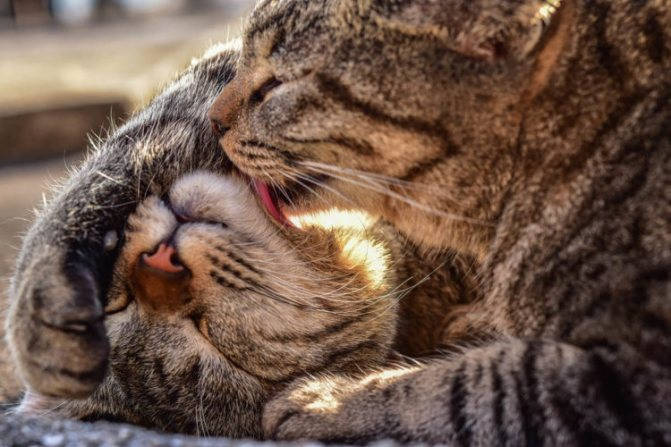
- Why cats lick each other
- Cat licking a cat
- Why a cat licks the owner
- Ways to eliminate this habit
- Licking is associated with a higher ranking
- Maternal Instinct
- Blessing
- Reasons why cats lick each other
- You're my brother!
- Cats lick each other in order to get closer.
- Cats lick each other to strengthen family bonds.
- Licking is associated with higher rank
- There may be a maternal instinct involved.
- Diagnosis and treatment of possible diseases
- Prevention
Why cats lick each other
The fact that cats lick themselves at every opportunity (after contact with people as well) is known to all the owners of purrs. If two cats live in the apartment at once, the owners will witness synchronous washing and even licking each other. Why do cats do it?
There are several reasons. They are simple, but interesting. Feline logic becomes immediately understandable.
Animal behavior does not lend itself to human logic. Many things are incomprehensible to bipeds in the movements of pets. Today we'll figure out why cats living in the same apartment wash each other.
First There can be a real sympathy between them. Not necessarily blood ties, but mutual love, as between close relatives. After all, two pets share the same territory without fighting, so why not help wash the neighbor? This is how they show affection for a member of their family, the pack. A cat will never lick a strange animal! Cats that were taken into the same family at the same age most often care for each other.
Cats love cleanliness. This is second reason , why they will wash not only themselves, but also the neighbor, to keep everything around them clean and comfortable to commiserate.
A little selfishness: cats can't reach all parts of the body, so they use their mate's tongue to wash the areas they can't reach on their own.
Mama cats wash kittens for the same reason: the crumbs themselves are not yet able to take care of themselves, so the adult will often lick them. This is how kittens become accustomed to daily toiletting. From 4 weeks of age, kittens are already learning lessons from their mother and begin to lick themselves.
The third reason lies in feline hierarchy and status reinforcement. Yes, there are social structures in the cat world. Studies have found that higher-ranking cats wash their inferior relatives.
Besides, the washers can behave in a passive-aggressive way, hissing at those whom they lick, once again demonstrating their power and high status. This way they secure their territory. Suddenly, a cat of a higher rank wants to lie down on the place of a congenie, and then it will start licking another animal until it leaves the occupied territory. Sometimes licking is not an act of love, but a reinforcement of power play.
Cat licking a cat
Most of the time, a cat that licks pays attention to areas such as the cheekbone area, the scruff of the neck, and the vertex. In addition to getting to know each other, cats show concern for each other by grooming their coats.
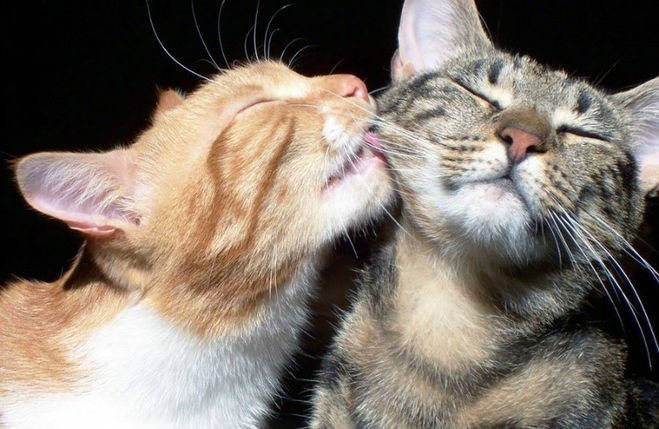
As for the question of a cat licking another cat, it makes more sense. But how to explain the cat's behavior when it licks the dog. Some owners notice that the cat rubs its muzzle and torso against the dog. First of all, this is a kind of marking.
In the corners and around the cat's mouth there are specific glands. They are also located in the temporal area. During rubbing, the glands open and the specific secret remains on the object the animal rubs against. The glands are also located at the base of the tail.
It is an interesting fact, proven by zoopsychologists, that cats, feeling stronger in the hierarchical ladder, lick the weaker, proving their superiority. Cats can also lick their owners in response to being petted, thus showing their gratitude.
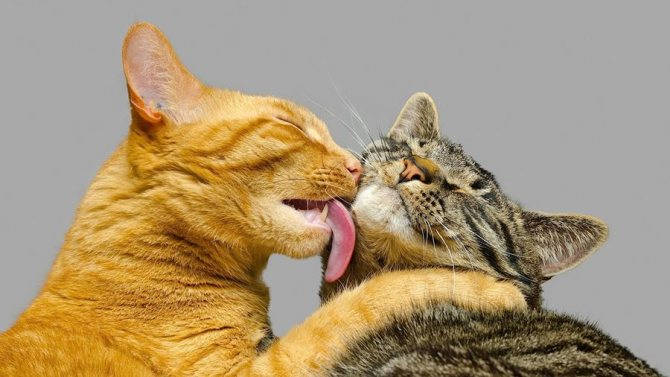
Due to the high volume of questions, free veterinary consultation is temporarily suspended.
Why a cat licks the owner
There are also a number of other factors that trigger a domestic cat's habit of licking its owner. The cat may have friendly feelings toward its owner.
The mother cat licks her kittens from birth, showing concern for her offspring. As the kitten grows older, it begins to lick its siblings. If a cat starts licking its owner, such as its hands, it can be seen as a show of care.
Another reason for a cat to lick a person's hands is to indicate who is in a dominant position. The assertion of rights to territorial boundaries, occurs through smell. By licking the owner, the cat leaves a piece of scent, thus proving to all other animals that it is his person. If the cat does not show aggressive feelings, then there is no need to worry about it.
Asking for treats is not uncommon for cats, so they may go to such lengths as licking the owner's hands. This should not be allowed, as the cat will become completely spoiled and unmanageable.
Feed the pet strictly according to the food schedule. You should not give treats, especially from the human table.
Ways to eliminate this habit
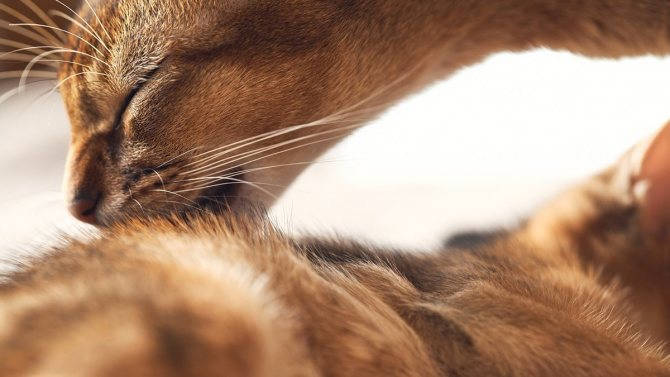
In case the owner of licking the cat brings discomfort, it is necessary to get rid of this behavior gently. For this purpose, it is necessary to purchase a special toy, which can be used to distract the animal every time it will make attempts to lick. In some cases, catnip is excellent. You can purchase a ball with a smelly grass inside.
Distracting the animal can be played with. This is especially true for small kittens, whose habits are only getting stronger. Playing with your pet not only helps to instill good habits, but is also good for your pet's overall development. In addition, if the animal is stressed, the biological substances produced by the body during physical activity allow it to relax.
It is difficult to retrain an animal that is used to it, so you must have patience. We must handle retraining gently, without raising your voice, without punishing the animal, without frightening it with harsh movements. Categorically pushing and throwing the cat to the floor.
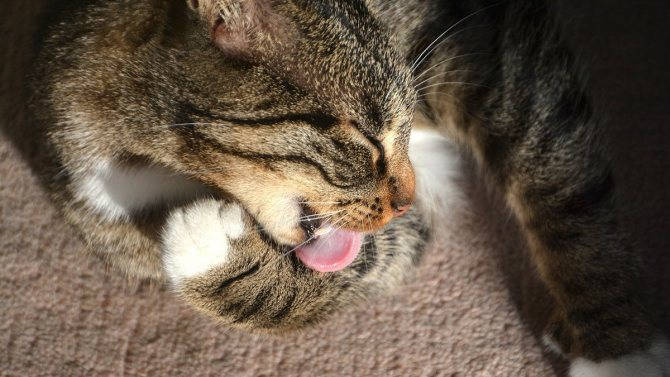
Due to the high volume of questions coming in, free veterinary consultations have been temporarily suspended.
Licking is associated with a higher ranking
Another, earlier study found that in most cases, higher-ranking cats were groomed by lower-ranking members. And more often than not, those animals being licked are sitting or lying down when the caregivers are in a higher ranked posture – standing or sitting upright. The cat, without resorting to fighting or other aggressive actions, can show its dominance by licking the other.
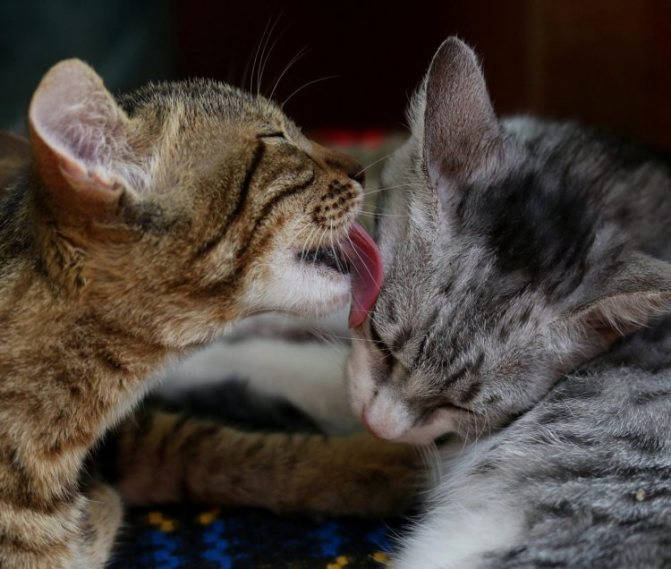
Maternal Instinct
The licking of her kittens by the mother cat shows not only the hygiene of the babies, but also other things that are necessary for the cubs' lives:
By three weeks, kittens can already lick themselves. Then they begin to lick their siblings, reinforcing the bond of kinship. A cat can continue to lick her babies even as an adult. Scientists have observed that the babies of unscrupulous mothers who have poorly cared for their brood grow up to be just as sloppy.
Blessing
It is worth noting that only those cats that are close and between whom there is a good relationship will help wash each other. So if your veteran cat accepted to help wash the newcomer, it means he is accepted into your feline fraternity. One can even say that in this way cats bless each other. Perhaps your only cat lacks a companion to help her lick behind her ears.
Also, licking the other cat means that they have managed to agree on a hierarchy. Namely, to determine which one of them will hold the main position in the house. The one who washes the other's tongue is more important and dominant, and the one who gets licked at the back of the head, it turns out, agrees to accept the rules of the cat-dog.
Do your cats wash each other? What's their relationship like?
Reasons why cats lick each other
Who is the epitome of self-sufficiency and the benchmark of selfishness? Of course, the cat! It is an opportunist to the bone, indifferent to all and everything that does not bring benefits. And how could she have any other image when she is a solitary animal, never crossing the borders of her own domain all her life and communicating with her kin only on business. This is so and – NOT so.
All of the above is true when the cat lives in natural conditions, that is, at a sufficient distance from the benefits of human civilization.
But in unnatural conditions, i.e. near a human dwelling and even more so inside it, a cat is capable of a relationship with congeners. And even very complicated relations! This incredible metamorphosis can be explained by the exceptional flexibility of the cat's psyche.
How do cats communicate? Like all their kind: with gestures, looks, sounds, smells and touches. One type of touch… mutual licking (grooming), is what we're going to talk about.
Of course, visual, acoustic, olfactory (smell) and tactile signals can be both friendly and hostile. What type does licking refer to?
According to many studies, it is friendly (at least, not hostile). What does the cat want to show by licking the fellow cat? It all depends on the specific situation.
You're my brother!
When licking each other, cats exchange scents. This is done in order to "twin" and then quickly distinguish a stranger from their own. Of course, when kept in apartments this "kind" of licking makes no sense, but outdoors it is very important.
It happens so that one cat assiduously and diligently licks another, despite the attempts to avoid the intrusive service. It is supposed that in this way the "well-wisher" demonstrates to the "client" her superiority.
Cats lick each other in order to get closer.
This daily process is not always functional. Some cats, when together, may lick each other to show love and trust in their mate. The licking serves to strengthen the bond between the pets.
How do you know if the animals are really close to each other? In such cases, licking usually focuses on the face and ears, the cats' favorite places to show affection
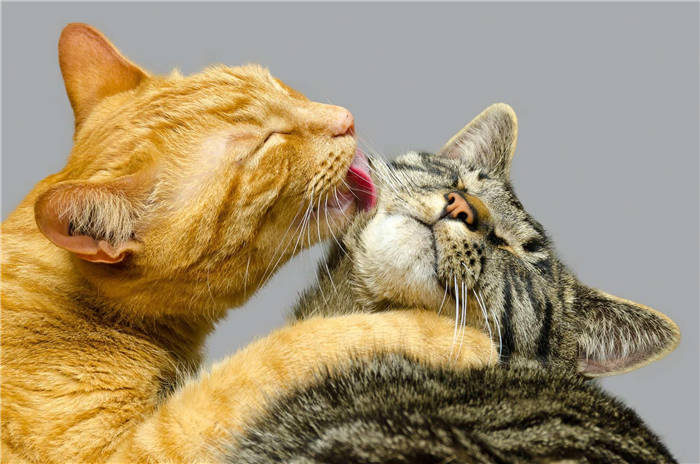
Cats lick each other to strengthen family bonds.
Adult cats often spend a lot of time licking their cubs. They do this both to identify them as members of their family and to alert others that the kittens are part of their territory.
If the mother does not lick her kittens enough, it can cause an odor change that may even lead to rejection. This process reinforces the necessary bonding, without which serious problems can arise. Even when the kittens are older, they will continue to lick each other to strengthen the family bond.
This point may lead to the question of why a cat licks its owner. It means that she considers the person a member of her family.
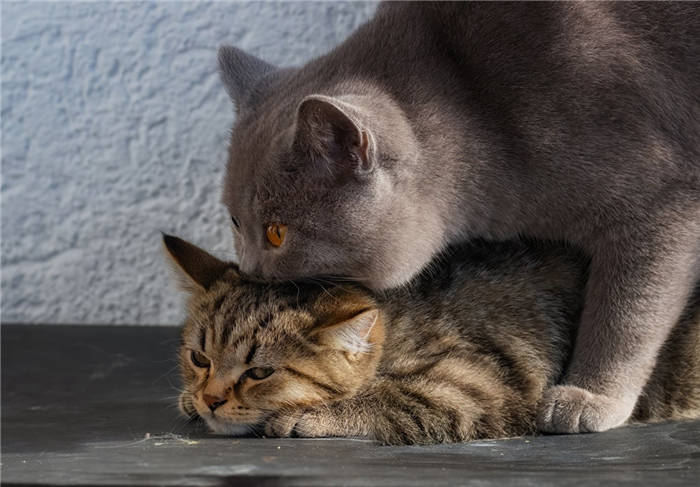
Licking is associated with higher rank
Another, earlier study found that in most cases, higher-ranking cats groom lower-ranking members. The animals being licked are more likely to sit or lie down when the caregivers assume higher positions – standing or sitting upright. The cat, without resorting to fighting or other aggressive actions, can show its dominance by licking the other.
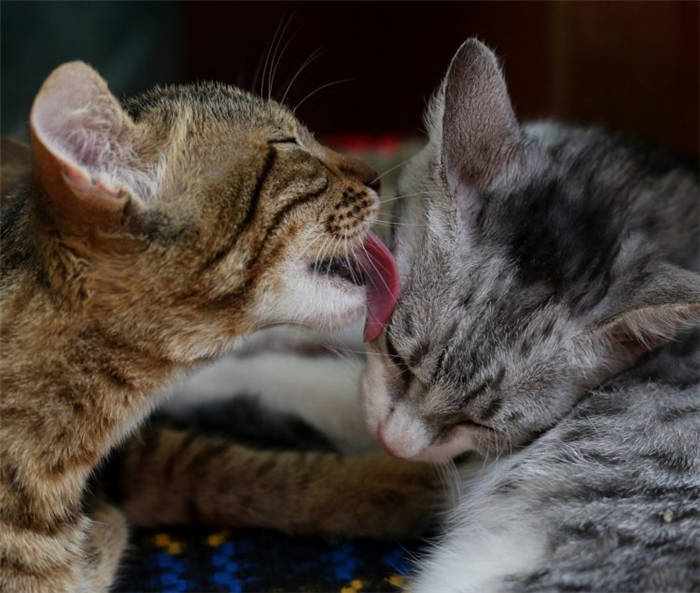
There may be a maternal instinct involved.
For the first time kittens are defenseless and unskilled and therefore depend on their mother for everything, including bathing. In this case the licking is a sign of attachment and protection from the mother. But already by the age of 4 weeks, the kittens know how to bathe themselves and spend more than 50% of their waking time keeping them clean.
Based on research, this behavior is a sign of social acceptance and closeness between animals. Also, allogrooming may be motivated by the need for help with maintaining cleanliness. In addition, cats adopt the behavior of their mothers, so they can also lick each other. Finally, allogrooming can demonstrate social hierarchy.
Diagnosis and treatment of possible diseases
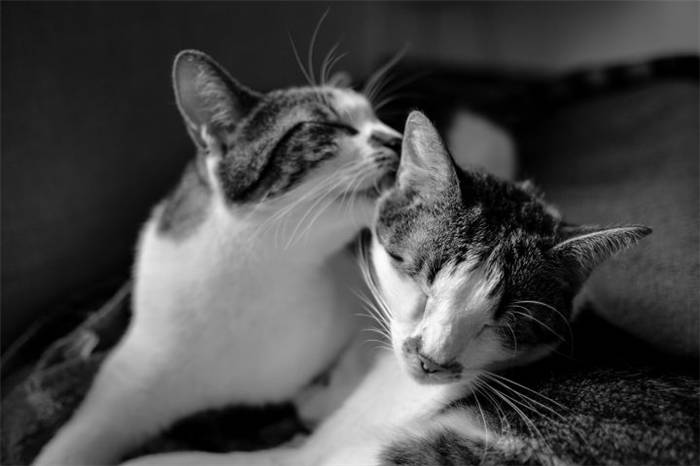
Depending on the factors that provoked the disease, a specialist will prescribe treatment. Without prior diagnosis, no therapy can be prescribed.
If the formation of baldness on the animal's body is associated with fungal lesions or bacterial infection, scrapings of the skin and further examination under a microscope are carried out. Collection of a medical history is important, allowing the veterinarian to look in the right direction. A general blood test and a biochemical panel are also prescribed, which allows to assess the condition of the internal organs.
Based on the data obtained, the doctor develops a treatment plan. If the cause of baldness in a cat was nervous tension or stress, mild sedatives are prescribed.
If bacterial diseases are diagnosed, a course of antibiotic therapy is carried out. Fungal skin infections that cause itching and baldness are treated with antifungal drugs. In this case, the duration of treatment drags on for several weeks.
With severe itching on the cat's skin, provoked by food allergies, a correction of the diet and elimination of the underlying triggering factors is carried out. Corrective diet should not contain allergens. Antihistamines are prescribed for oral administration, as well as local anti-allergic agents in the form of ointments and liniments.
Prevention
In order to prevent the occurrence of baldness against the background of frequent licking of the cat's fur, it is necessary to monitor the general condition of the animal. If the cat pays increased attention to its fur, it is necessary to contact the veterinarian for help so as not to miss the development of dangerous pathological processes.
It is necessary to monitor the cat's diet, give enough freedom without restricting the pet's movements. For preventive purposes, it is recommended to give the cat special pastes to remove the hair lumps formed from the gastrointestinal tract. This will prevent blockages in the digestive system.

Due to the high volume of questions, free veterinary consultations have been temporarily suspended.






